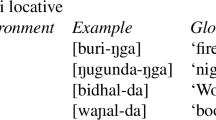Abstract
This paper investigates the question of how much work phonology can do in accounting for apparently suppletive but phonologically predictable allomorphy. Two case studies of surface alternations in the domain of morphological tone are discussed and monorepresentational optimality theoretic analyses are proposed that predict the apparent suppletive allomorphies from a single underlying representation for the morphemes in question.
Similar content being viewed by others
Notes
It has to be noted, though, that nothing crucially hinges on this and that the analysis could in principle be reimplemented in correspondence-theoretic OT (McCarthy and Prince 1995, et seq.).
The constraint type and its implications for other areas of non-segmental affixes are discussed in Trommer and Zimmermann (2014).
Or before the second tone. Since all bases in SMG are binary, both analyses make the same prediction.
Mixtec languages vary in whether there is evidence for one or the other claim. Whereas Buckley (1991) argues that M is indeed the absence of tone in Chalcatongo Mixtec, there are various Mixtec languages where true contour tones involving M-tones exist and M hence trivially cannot be the absence of tone (e.g. in San Esteban Atatláhuca Mixtec, Mak 1953; or Yucunany Mixtepec Mixtec, Paster and Beam de Azcona 2004). In the SMG tone system, there is no independent evidence that favours one or the other assumption.
Note that Max(T-μ) is ranked above #H! ensuring that bases which are underlyingly specified for LH realize this tonal melody faithful and do not, for example, spread the H to the initial TBU to avoid a violation of #H!.
There is no agreement whether the glottal is a segment on its own (Tranel 1995b), a glottalization feature on a vowel McKendry (2013), or even on a whole couplet (Macaulay and Salmons 1995). I follow the assumption in Tranel (1995b) that it is indeed a glottal stop. However, nothing hinges on that: an interaction of a glottal stop with tone is as expected and well attested as an interaction of vowel phonation type and tone (cf. e.g. Yip 2002; Silverman 1997).
Note that this is different from the assumptions in Tranel (1995b) where a glottal specification intervenes on the tonal tier. This relies on a concept of NoCrossing where non-parallel pairs of (to be) associated elements interact: a glottal specification on the tonal tier associated to a segmental root node/timing tier blocks association of a tone to its TBU on the moraic tier. This is in contrast to the definition of NoCrossing in (6-a).
An interesting restriction is that words in KK can be specified for maximally two tones and the distribution of tone to words with fewer TBU’s than tones is consistent with a derivational account where 1:1 association of tones to TBU’s starts at the right edge (Baart 1999b, 91).
There are additional vowel quality changes that are ignored in the following. Whereas masculine words form their inflected form via a change from /a/ to /ä/, feminine words show /u/ → /i/, /o/ → /e/, /ä/ → /i/, and /a/ → /e/ (Baart and Zaman Sagar 2004, 21). It is assumed that the representation for the inflection morpheme is in fact more complex and contains additional floating vowel features that cause this mutation.
The term ‘complete overwriting’ is hence not entirely correct: only L-tones of the base are overwritten by the H.
Given the assumption that coda consonants are always moraic and that trimoraic syllables are marked, the stem stratum predicts that the second μ in CVːC syllables is shared (Broselow et al. 1997) and associated to both V and C as can be seen in (27). A syllable with three μ’s is expected to surface, however, in contexts where the inflected forms of nouns ending in a long vowel is optimized: realization of both the affix-μ and the stem-μ’s is more important than the avoidance of trimoraic syllables.
That the inflected form for some nouns is marked via suffixation and not the regular tonal change is apparently idiosyncratic; as is the choice between the plural suffixes.
In fact, this could also be analysed as the more general ban on words with more than three tones (cf. footnote 9) that holds on the surface for all words in KK.
References
Anderson, S. R. (1992). A-morphous morphology. Cambridge: Cambridge University Press.
Baart, J. L. G. (1997). The sounds and tones of Kalam Kohistani. SIL, Dallas.
Baart, J. L. G. (1999a). A sketch of Kalam Kohistanti grammar. National Inst. of Pakistan Studies, Islamabad.
Baart, J. L. G. (1999b). Tone rules in Kalam Kohistani (Garwi, Bashkarik). Bulletin of the School of Oriental and African Studies, 62, 88–104.
Baart, J. L. G. (2004). Contrastive tone in Kalam Kohistani. Linguistic Discovery, 2, 1–20.
Baart, J. L. G., & Zaman Sagar, M. (2004). Kalam Kohistani texts. National Inst. of Pakistan Studies, Islamabad.
Beckman, J. (1998). Positional faithfulness. PhD thesis, University of Massachusetts at Amherst.
Bermúdez-Otero, R. (2012). The architecture of grammar and the division of labour in exponence. In J. Trommer (Ed.), The morphology and phonology of exponence: the state of the art (pp. 8–83). Oxford: Oxford University Press.
Bermúdez-Otero, R. (2015, in preparation). Stratal optimality theory. Oxford: Oxford University Press.
Broselow, E., Chen, S.-I., & Huffman, M. (1997). Syllable weight: convergence of phonology and phonetics. Phonology, 14, 47–82.
Buckley, E. (1991). Low-tone spreading in Chalcatongo Mixtec. In J. Redden (Ed.), Papers from the American Indian languages conferences: occasional papers on linguistics (Vol. 16, pp. 168–172). Southern Illinois University.
Bye, P., & Svenonius, P. (2012). Non-concatenative morphology as epiphenomenon. In J. Trommer (Ed.), The morphology and phonology of exponence: the state of the art (pp. 426–495). Oxford: Oxford University Press.
Davis, S., & Ueda, I. (2002). Mora augmentation processes in Japanese. Journal of Japanese Linguistics, 18, 1–23.
Dolphyne, F. A. (1996). A comprehensive course in Twi (Asante). Accra: Ghana University Press.
Goldrick, M. (2000). Turbid output representations and the unity of opacity. In A. Coetzee, N. Hall, & J. Kim (Eds.), NELS 30 (pp. 231–245). Amherst: GLSA.
Goldsmith, J. A. (1976). Autosegmental phonology. PhD thesis, MIT.
Goldsmith, J. (Ed.) (1990). Autosegmental and metrical phonology. Oxford: Blackwell.
Hansson, O. G. (2004). Tone and voicing agreement in Yabem: representations vs. constraint interaction. Davis, CA. WCCFL 23.
Hollenbach, B. (2003). The historical source of an irregular Mixtec tone-sandhi pattern. In M. R. Wise, T. Headland, & R. Brend (Eds.), Language and life: essays in memory of Kenneth L. Pike (pp. 535–552). Dallas: SIL International.
Horwood, G. (2001). Antifaithfulness and subtractive morphology. Ms., Rutgers University, available as ROA 466-0901.
Kingston, J. (2005). The phonetics of Athabaskan tonogenesis. In S. Hargus & K. Rice (Eds.), Athabaskan prosody (pp. 137–184). Amsterdam: Benjamins.
Kurisu, K. (2001). The phonology of morpheme realization. PhD thesis, UC Santa Cruz.
Leben, W. (1973). Suprasegmental phonology. PhD thesis, MIT.
Lee, S. (2008). Consonant-tone interaction in optimality theory. PhD thesis, Rutgers University.
Lieber, R. (1992). Deconstructing morphology. Chicago: University of Chicago Press.
Macaulay, M., & Salmons, J. C. (1995). The phonology of glottalization in Mixtec. International Journal of American Linguistics, 61, 38–61.
Mak, C. (1950). A unique tone perturbation in Mixteco. International Journal of American Linguistics, 16, 82–86.
Mak, C. (1953). A comparison of two Mixtec tonemic systems. International Journal of American Linguistics, 19, 85–100.
Mascaró, J. (2007). External allomorphy and lexical representation. Linguistic Inquiry, 38, 715–735.
Matthews, P. H. (1974). Morphology. Cambridge: Cambridge University Press.
McCarthy, J., & Prince, A. (1995). Faithfulness and reduplicative identity. In J. Beckman, L. Dickey, & S. Urbanczyk (Eds.), UMOP (pp. 249–384). Amherst: GLSA.
McKendry, I. (2013). Tonal association, prominence and prosodic structure in South-Eastern Nochixtlán Mixtec. PhD thesis, University of Edinburgh.
Odden, D. (1988). Floating tones and contour tones in Kenyang. Studies in African Linguistics, 19, 1–34.
Paster, M. (2006). Phonological conditions on affixation. PhD thesis, University of California, Berkeley.
Paster, M. (2010). The verbal morphology and phonology of Asante Twi. Studies in African Linguistics, 39, 77–120.
Paster, M., & Beam de Azcona, R. (2004). A phonological sketch of the Yucunany dialect of Mixtepec Mixtec. In C. Jany (Ed.), Proceedings of the 7th annual workshop on American indigenous languages, UC Santa Barbara.
Perkins, J. (2013). Consonant-tone interaction in Thai. PhD thesis, Rutgers University.
Pike, E. (1986). Tone contrasts in central carrier (Athabaskan). International Journal of American Linguistics, 52, 411–418.
Pike, K. L. (1944). Analysis of a Mixteco text. International Journal of American Linguistics, 10, 113–138.
Pike, K. L. (1948). Tone languages. Ann Arbor: University of Michigan Press.
Prince, A., & Smolensky, P. (1993/2004). Optimality theory: constraint interaction in generative grammar. Oxford: Blackwell. First circulated as Prince and Smolensky (1993), Technical reports of the Rutgers University Center of Cognitive Science.
Pulleyblank, D. (1986). Tone in lexical phonology. Dordrecht: Reidel.
Revithiadou, A. (2007). Colored turbid accents and containment: a case study from lexical stress. In S. Blaho, P. Bye, & M. Krämer (Eds.), Freedom of analysis? (pp. 149–174). Berlin: Mouton de Gruyter.
Ruangjaroon, S. (2006). Consonant-tone interaction in Thai: an OT analysis. Taiwan Journal of Linguistics, 4, 1–66.
Silverman, D. (1997). Phasing and recoverability. New York: Garland.
Stonham, J. (1994). Combinatorial morphology. Amsterdam: John Benjamin.
Stonham, J. (2007). Metathesis as prosodic repair. Studies of Phonetics, Phonology and Morphology, 13, 3–24.
Story, G. (1989). A report on the nature of Carrier pitch phenomena: with special reference to the verb prefix tonomechanics. In K. Rice & E. D-Cook (Eds.), Athabaskan linguistics: current perspectives on a language family (pp. 99–144). Berlin: Mouton de Gruyter.
Stump, G. T. (2001). Inflectional morphology. Cambridge: Cambridge University Press.
Tang, K. (2008). The phonology and phonetics of consonant-tone interaction. PhD thesis, UC Los Angeles.
Tranel, B. (1995a). On the status of universal association conventions: evidence from Mixteco. In J. Ahlers, L. Bilmes, J. Guenter, B. Kaisse, & J. Namkung (Eds.), Proceedings of BLS 21 (pp. 299–312).
Tranel, B. (1995b). Rules vs. constraints: a case study. ROA-72.
Trommer, J. (2010). Paradigmatic generalization of morphemes. Linguistische Arbeits Berichte Leipzig, 88, 227–246.
Trommer, J. (2011). Phonological aspects of Western Nilotic mutation morphology. Habil., University of Leipzig.
Trommer, J., & Zimmermann, E. (2014). Generalised mora affixation and quantity-manipulating morphology. Phonology, 31, 463–510.
Urbanczyk, S. (2011). Root-affix asymmetries. In M. van Oostendorp, C. J. Ewen, E. Hume, & K. Rice (Eds.), The Blackwell companion to phonology. Malden: Wiley Blackwell. Chap. 104.
van Oostendorp, M. (2006). A theory of morphosyntactic colours. Ms., Meertens Institute, Amsterdam. Available online at http://egg.auf.net/06/docs/Hdt.
van Oostendorp, M. (2007). Derived environment effects and consistency of exponence. In S. Blaho, P. Bye, & M. Krämer (Eds.), Freedom of analysis? (pp. 123–148). Berlin: Mouton de Gruyter.
van Oostendorp, M. (2008). Incomplete devoicing in formal phonology. Lingua, 118, 1362–1374.
van Oostendorp, M. (2012). Stress as a proclitic in Modern Greek. Lingua, 122, 1165–1181.
Yip, M. (2002). Tone. Cambridge University Press.
Zimmermann, E. (2013). Non-concatenative allomorphy is generalized prosodic affixation: the case of Upriver Halkomelem. Lingua, 134, 1–26.
Zimmermann, E. (2014). A phonological account of morphological length. PhD thesis, Leipzig University.
Acknowledgements
For valuable comments and discussion I am grateful to the participants of the colloquium Neuere Arbeiten zur Grammatiktheorie at Leipzig University, of the Conference on Allomorphy: its Logic and Limitations (Jerusalem, July 6–8, 2014) and of AMP 2015 (Vancouver, October 9–11, 2015). I am also indebted to two anonymous reviewers for their constructive comments. This research was supported by a DFG grant to the project ‘Featural Affixes: The Morphology of Phonological Features’ (TR 521/6–1).
Author information
Authors and Affiliations
Corresponding author
Ethics declarations
Compliance with Ethical Standards
The research did not involve Human Participants and/or Animals.
Disclosure of potential conflicts of interests
This work was supported by a research grant of the German Research Foundation (TR 521/7-1). Otherwise, there are no conflicts of interest.
Rights and permissions
About this article
Cite this article
Zimmermann, E. The power of a single representation: morphological tone and allomorphy. Morphology 26, 269–294 (2016). https://doi.org/10.1007/s11525-015-9276-x
Received:
Accepted:
Published:
Issue Date:
DOI: https://doi.org/10.1007/s11525-015-9276-x




